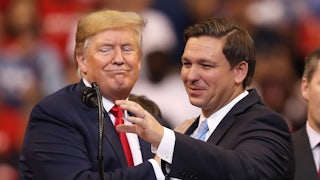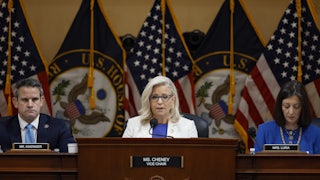In October 2020, President Donald Trump signed an executive order creating a new class of civil servant that would no longer enjoy civil service protections from firing. The stated reason was to remove incompetents, who can be difficult to fire. The real reason was to eliminate government employees who were insufficiently loyal to Trump’s policies.
As Jonathan Swan reports in an excellent Axios story posted Saturday, the executive order (which Biden revoked two days after his inauguration) was the brainchild of James Sherk, a special assistant on the Domestic Policy Council in charge of labor policy. Sherk tipped his hand earlier this year when he published a report (“Tales From the Swamp: How Bureaucrats Resisted President Trump”) documenting examples not of incompetence but rather of purported disloyalty. For example, Sherk complained, the regulatory staff of the Department of Labor said it needed a whole year to draft a “priority regulation” that “a competent private sector attorney could have produced … in two to three weeks.” Reality check: A year is what it usually takes, because a federal agency (unlike a “competent private sector attorney”) must issue a notice of proposed rulemaking and do various other things required under the 1946 Administrative Procedure Act to encourage public participation. If an unwillingness to break the law constitutes disloyalty, then, yes, Trump encountered a fair amount of disloyalty—among civil servants and even some political appointees—during his four years in office, especially at the end.
Trump was especially blunt about the executive order’s intent. Here’s what The Washington Post reported him saying shortly after the executive order was issued:
You have a lot of people from past administrations, and they’re civil service. I fired some. I say some, just get rid of them. We had a lot of them come to the floor during the impeachment hoax. You see them coming in with their bow ties and everything. It’s a weird deal. We have some pretty deep-set, deep-seated people—we got a lot of them, and we got rid of a lot of them.
Trump lost the election a month later, and so departed the White House before the desired purge could take place. But Swan reports that if Trump wins back the presidency in 2024, he will try to reinstate the executive order and to replace federal bureaucrats with the MAGA faithful. “To drain the swamp, we need to fire the swamp,” read the prepared text of a speech Trump gave Saturday night at the Turning Point USA Student Action Summit.
Reinstating Trump’s executive order on the civil service would be a catastrophe. As I reported in a New Republic story that came out around the same time as Sherk’s report (“Washington Is Not a Swamp”), the civil service kept the lights on during the Trump years while Trump and his minions did their best to lay waste to every rule-of-law norm, right up to and including democratic elections. As I concluded in my earlier piece, these federal bureaucrats, quite contrary to Trump’s view and their general reputation, “shape your nation’s capital, inspire it, and keep it afloat, and you should feel grateful for them every single goddamned day.”
People don’t know about the work civil servants do because they seldom talk to the press. The press, in turn, downplays the civil service’s importance because the alternative—acknowledging that a large and powerful cohort within the federal government does not make itself available to reporters—is too awkward to acknowledge openly. Every now and then, though, the public gets a glimpse. On July 11, Kenneth Chang of The New York Times published a profile of Gregory Robinson, project manager of the James Webb Space Telescope. (The Washington Post’s Courtland Milloy also profiled Robinson earlier this year.) Robinson’s is an inspirational story. He is African American and the ninth of 11 children born to Virginia sharecroppers. He went to college on a football scholarship and eventually earned an MBA. He’s worked at NASA since 1989.
Robinson was put in charge of the Webb Space Telescope in 2018. Deadlines were not being met, and Congress was reluctant to appropriate more money. Robinson got the project back on track, raising its “schedule efficiency” from 55 percent to 95 percent. The results—breathtaking images of the universe released earlier this month that are already changing scientists’ understanding of its origins—speak for themselves. “The speed at which he turned this thing around was just astounding,” Thomas Zurbuchen, NASA’s associate administrator for science, told the Times.
Let’s compare Robinson to the sort of Trump loyalist we’re likely to see in a second Trump administration. Meet Garrett Ziegler, 26. He is a former aide to Trump White House trade adviser Peter Navarro. Ziegler claims credit—and I can’t think why we wouldn’t let him take it—for escorting Michael Flynn, Sidney Powell, Rudolph Giuliani, and Patrick Byrne into the Oval Office for the much-discussed “clown car” meeting on election fraud conspiracies on December 18, 2020.
Ziegler was called to testify last week before the January 6 select committee. Mostly he invoked what he called “my right to silence,” by which he meant his Fifth Amendment right not to incriminate himself. Afterward, Ziegler said he was the target of “a Bolshevistic anti-white campaign.” Ziegler also described former Trump White House aides Cassidy Hutchinson and Alyssa Farah Griffin, who cooperated with the committee, as “total hos and thots.” (“Thot” is an acronym for “That Harlot Over There.”) If you think Ziegler’s hateful words and the crackpot company he keeps bar him from receiving a choice appointment in any future Trump administration, then you haven’t been paying attention.
(Though it’s hardly his fault, I can’t resist adding that Ziegler is cousin to the late Ron Ziegler, the Nixon White House spokesman who, two days after the Watergate break-in, famously dismissed it as “a third-rate burglary attempt.… Certain elements may try to stretch this beyond what it is.”)
Perhaps you feel skeptical that Trump will win back the White House. I am, too (though I was also skeptical—more than skeptical, actually—that he’d win in 2016). But that may not matter. Trumpian politics have settled in to the GOP for the next while, even if the man himself should fail to claw his way back. A Republican president who isn’t Trump will very likely want just as much as Trump did to fire civil servants en masse and replace them with political hacks. So let’s take a closer look at what this godawful executive order, if reinstated, might do.
As Swan tells the story, Sherk’s eureka moment occurred in January 2019, when he discovered Section 7511 of Title Five of the U.S. Code. (Title Five is the set of laws governing the civil service.) Section 7511 exempts from civil service job protections any person “whose position has been determined to be of a confidential, policy-determining, policy-making or policy-advocating character.” That gave Trump an opening to create a special category of civil servant that he called Schedule F. (The name’s rich expressiveness of hostile intent is entirely fortuitous; there already exist schedules A through E.) Agency officials were ordered to find civil servants to herd into a Schedule F classification, where they could be fired or terrorized into submission. The Office of Personnel Management, noting that the terms “confidential,” “policy-determining,” “policy-making,” and “policy-advocating” lacked clear statutory definition, encouraged agencies to interpret them broadly. A lot of the agency heads, according to Swan, blew this off after Trump lost the election. But Russ Vought, director of the Office of Management and Budget, proposed reclassifying no fewer than 88 percent of his employees as Schedule F.
When 88 percent of the civil servants at an agency are reclassified as at-will, you are effectively repealing the Pendleton Civil Service Reform Act of 1883 and its subsequent revisions by Congress. The Pendleton Act was passed two years after Charles Guiteau shot and killed President James Garfield because Garfield wouldn’t appoint him consul to Paris or Vienna. There was a general feeling that the spoils system of political appointments by the party in power (during the post–Civil War era, that was nearly always the Republicans) had gotten out of hand. Here’s how Mark Twain and Charles Dudley Warner described the state of affairs in 1873 (in their novel published that year, The Gilded Age):
If you are a member of Congress (no offense), and one of your constituents who doesn’t know anything, and does not want to go into the bother of learning something, and has no money, and no employment, and can’t earn a living, comes besieging you for help, do you say, “Come my friend, if your services were valuable you could get employment elsewhere—don’t want you here”? Oh, no. You take him to a Department and say, “Here, give this person something to pass away the time at—and a salary”—and the thing is done. You throw him on his country. He is his country’s child, let his country support him.
The Pendleton Act restored some balance by creating a class of career officials able to accumulate experience in governing who would work under political appointees. It was succeeded in 1978 by the Civil Service Reform Act, which reorganized various functions of the civil service but didn’t alter the basic principles underlying the Pendleton Act.
Can a president effectively repeal these 1883 and 1978 laws without consulting Congress? We never got a chance to find out because Trump’s executive order got revoked three months later. But the National Treasury Employees Union argued plausibly, in a lawsuit filed in October 2020, that the president lacks the necessary authority. The union’s complaint for injunctive relief conceded that Trump possessed the power to exempt certain civil servants from civil service protection. But it further noted that the statute in question stipulated that this could be done only when “necessary” and “as conditions of good administration warrant.” The wholesale herding of federal employees into Schedule F did not, the NTEU argued, meet these conditions. We’ll hear this argument again if Schedule F ever reappears.
The House earlier this month included in a Pentagon spending bill an amendment barring any future president from corralling civil servants into a new, fireable category of employment. The bill is now before the Senate, where the amendment’s future is uncertain. But the states have for some time been moving to water down or eliminate civil service protections at the state and local level.
Such policies are favored mostly by limited-government Republicans, but the New Democrat journalist David Osborne, co-author of the book Reinventing Government, has pushed it too. Indeed, it was a Democrat—Georgia Governor Zell Miller—who led the way in 1996. By now, 28 states have adopted some form of “at-will” employment. The changes have taken a toll on the morale of state and local government workers.
A president has 4,000 political appointments to make, of whom 1,200 require Senate confirmation. Trump didn’t work very hard to fill these slots, and by the end of his administration, most agencies had fewer than 70 percent of their Senate-confirmed positions filled. The Pentagon had less than half, the Justice Department had about a third, and the Homeland Security Department had less than one-quarter. All three were run by acting secretaries. This despite the facts that Trump enjoyed a Senate majority throughout his presidency and that Senate rules barred the minority from filibustering presidential appointments. If Trump felt a need for more loyal employees in the executive branch, why didn’t he fill these vacancies?
Granted, civil servants have political appointees outnumbered. There are about two million of them situated around the country, about one-third of them working for the Pentagon. Still, the caricature of the federal civil service as some out-of-control bureaucracy that grows like kudzu is 100 percent false. Today’s total civilian government employment is about what it was 70 years ago. The Deep State is no deeper in 2022 than it was back in 1952. If a Republican is elected president in 2024, he (or she) should leave it the hell alone.






